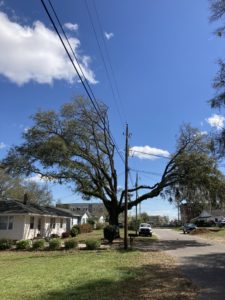If you have been following the Aii educational series Modern Roots March this month, you’ll know that we want to get you thinking about underground utilities like you think about the roots of plants and trees. The reason is simple: if you start to recognize that modern life is supported and sustained by pipes, cables, and wires underground, you will be more likely to think before digging and damaging something underfoot.
Just like digging near a tree gives you pause about striking a root with your shovel, digging near buildings and homes should give you pause about what roots may be sprawling out from the structure connected to the power grid, sewage system, and other private and municipal utilities.
But we have not yet paused to ask why there are modern roots in the first place? Why are so many things buried instead of simply set up above ground? Wouldn’t that avoid excavation damage from blindly digging into them?
There are a number of reasons for undergrounding, or transitioning utilities and other lines underground. They range from aesthetics to resilience, and different localities and companies have their own nuanced reasons. It can also be a sign of the age of an area – older neighborhoods tend to have above ground power and telephone lines, while newer communities tend to hide these underground.
The first reason may be related to appearance. Most people turn a blind eye to telephone lines and electrical transmission and distribution lines overhead, but once you pay attention, these can be eyesores in otherwise nice neighborhoods, business areas, and communities. In the 1960s, First Lady “Lady Bird” Johnson initiated a nationwide beautification campaign aimed at improving the look of utilities and their impact on the environment. Studies even explored the connection between aesthetic appeal and economics, analyzing ways that value is created or diminished by certain appearances.
If you are thinking that wires overhead running down to homes is not that bad, consider how companies maintain these lines.

The undesirable look of mangled trees and other plants are off-putting and lead many to argue that on the basis of look alone, lines should be buried wherever possible. But trees present a second reason that many utilities go underground: maintenance.
The amount of work it takes to monitor and trim trees for the hundreds of miles of power lines and similar overhead features is costly. It can also be expensive to maintain and dangerous to workers. Lines underground tend to be insulated from this type of maintenance and few disruptions occur – aside from the obvious threat of excavation damage and blind digging projects.
The tree presents still another reason that utilities are placed underground: storm damage and other incidents. Telephone and distribution infrastructure is uniquely threatened by things like powerful storms, wind, and rain. Falling trees and even vehicle accidents can knock down lines and wreak havoc. Tall trucks and hot air balloons among other conveyances damage power lines and lead to death and injury not infrequently. Squirrels, birds, and other animals can also disrupt them. By contrast, wind and rain have virtually no effect on pipes, cables, and wires placed several inches to several feet underground. In coastal regions, it is common to have utilities buried, while for other inland areas it may be less common. Subsurface utilities again are insulated from common threats above ground.
Undergrounding can be a component of infrastructure resilience, by making utilities and other facilities better suited to withstand weather, accidents, and intentional threats. That said, it can be expensive. To transition from overhead to underground requires significant investment, while simply burying new infrastructure may be less costly.
Then, of course, the threat of digging remains a top concern. Generations of Americans are used to their power and phone service being overhead, and they tend not to think about pipelines as features of their domestic life – those are big, long stretches carrying oil across the heartland. Others were raised not thinking about utilities at all. In an age of wireless Internet, younger generations take physical infrastructure for granted, taking “wireless” far too literally. That is why Modern Roots March is so important – we must reeducate people on the world around them, and the world underfoot!
Until everyone with a shovel recognizes and truly understands that modern life is made possible by roots supplying services to their homes and businesses, we will still see far too many damage incidents to pipelines, cables, and wires below the ground. Fortunately, organizations like Aii, the Common Ground Alliance, over 40 state and regional One-Call centers, individual utility and locating companies, and federal agencies like the Pipeline and Hazardous Materials Safety Administration (PHMSA) are on a never-ending quest to educate.
Has this blog or Modern Roots March given you a better understanding of infrastructure? Do you have a friend who may need to learn about these topics? Engage with us and them on social media! Follow @AiiNonProfit and the #ModernRootsMarch wherever you call home.
Written by Benjamin Dierker, Director of Public Policy
The Alliance for Innovation and Infrastructure (Aii) is an independent, national research and educational organization. An innovative think tank, Aii explores the intersection of economics, law, and public policy in the areas of climate, damage prevention, energy, infrastructure, innovation, technology, and transportation.